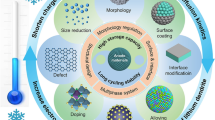Abstract
The first lithiation of graphite electrode was investigated by electrochemical impedance spectroscopy (EIS) and scanning electron microscope (SEM) in a two-electrode button cell and a three-electrode glass cell. The results demonstrate that the study of the variation of EIS feature of the graphite electrode in the two-electrode button cell with electrode polarization potential decreasing in the first lithiation cannot be used to investigate the formation mechanism of the solid electrolyte interphase (SEI) film. However, the formation and growth process of the SEI film can be acquired by investigating the variation of EIS features of the graphite electrode in the three-electrode glass cell with the decrease of electrode polarization potential in the first lithiation. Moreover, the results also point out that the SEI film on graphite electrode is mainly formed between 1.0 and 0.6 V in the first lithiation.
Similar content being viewed by others
References
Aurbach D. Review of selected electrode.solution interactions which determine the performance of Li and Li ion batteries. J Power Sources, 2000, 89: 206–218
Gnanaraj J S, Thompson R W, Iaconatti S N, et al. Formation and growth of surface films on graphitic anode materials for Li-ion batteries. Electrochem Solid-State Lett, 2005, 8: A128–A132
Piao T, Park S-M, Doh C-H, et al. Intercalation of lithium Ions into graphite electrodes studied by AC impedance measurements. J Electrochem Soc, 1999, 146: 2794–2798
Aurbach D, Gamolsky K, Markovsky B, et al. The study of surface phenomena related to electrochemical lithium intercalation into LixMOy host materials(M = Ni, Mn). J Electrochem Soc, 2000, 147: 1322–1331
Mantia F L, Vetter J, Novak P Impedance spectroscopy on porous materials: A general model and application to graphite electrodes of lithium-ion batteries. Electrochimica Acta, 2008, 53: 4109–4121
Levi M D, Aurbach D. Simultaneous measurements and modeling of the electrochemical impedance and the cyclic voltammetric characteristics of graphite electrodes doped with lithium. J Phys Chem B, 1997, 101: 4630–4640
Song J Y, Lee H H, Wang Y Y, et al. Two-and three electrode impedance spectroscopy of lithium-ion batteries. J Power Sources, 2002, 111: 255–267
Zhuang Q C, Xu J M, Fan X Y, et al. An electrochemical impedance spectroscopic study of the electronic and ionic transport properties of LiCoO2 cathode. Chinese Sci Bull, 2007, 52: 1187–1195
Holzapfel M, Martinent A, Allion F, et al. First lithiation and charge/discharge cycles of graphite materials, investigated by electrochemical impedance spectroscopy. J Electroanal Chem, 2003, 546: 41–50
Zhang S, Shi P. Electrochemical impedance study of lithium intercalation into MCMB electrode in a gel electrolyte. Electrochimica Acta, 2004, 49: 1475–1482
Aurbach D, Markovsky B, Nimberger A, et al. Electrochemical Liinsertion processes into carbons produced by milling graphitic powders: The impact of the carbons’ surface chemistry. J Electrochem Soc, 2002, 149: A152–A161
Gnanaraj J S, Levi M D, Levi E, et al. Comparison between the electrochemical behavior of disordered carbons and graphite electrodes in connection with their structure. J Electrochem Soc, 2001, 148: A525–A536
Zhuang Q C, Chen Z F, Dong Q F, et al. Effects of methanol contaminant in electrolyte on performance of graphite electrodes for li-ion batteries studied via electrochemical impedance spectroscopy. Chem Res Chinese Univ, 2005, 26: 2073–2076
Chang Y C, Sohn H J. Electrochemical impedance analysis for lithium ion intercalation into graphitized carbons. J Electrochem Soc, 2000, 147: 50–58
Martinent A, Le Gorrec B, Montella C, et al. Three-electrode button cell for EIS investigation of graphite electrode. J Power Sources, 2001, 97-98: 83–86
Naji A, Ghanbaja J, Humbert B, et al. Electroreduction of graphite in LiClO4-ethylene carbonate electrolyte. Characterization of the passivating layer by transmission electron microscopy and Fourier-trans-form infrared spectroscopy. J Power Sources, 1996, 63: 33–39
Wang C, Appleby A J, Little F E. Irreversible capacities of graphite anode for lithium-ion batteries. J Electroanal Chem, 2002, 519: 9–17
Chusid O, Ein-Ely E, Aurbach D, et al. Electrochemical and spectroscopic studies of carbon electrodes in lithium battery electrolyte systems. J Power Sources, 1993, 43: 47–64
Author information
Authors and Affiliations
Corresponding authors
About this article
Cite this article
Zhuang, Q., Tian, L., Wei, G. et al. Two-and three-electrode impedance spectroscopic studies of graphite electrode in the first lithiation. Chin. Sci. Bull. 54, 2627–2632 (2009). https://doi.org/10.1007/s11434-009-0356-3
Received:
Accepted:
Published:
Issue Date:
DOI: https://doi.org/10.1007/s11434-009-0356-3




